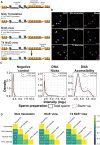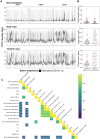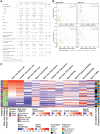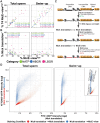Normozoospermic infertile men possess subpopulations of sperm varying in DNA accessibility, relating to differing reproductive outcomes
- PMID: 40375809
- PMCID: PMC12222617
- DOI: 10.1093/humrep/deaf081
Normozoospermic infertile men possess subpopulations of sperm varying in DNA accessibility, relating to differing reproductive outcomes
Abstract
Study question: Can a reliable assay be developed to quantify DNA accessibility in human sperm to help with the assessment of pre-implantation development affected by dense packaging of mammalian sperm's genetic material?
Summary answer: We adapted NicE-view, an assay that directly labels accessible DNA, for use in human sperm and applied it to examine spermatozoa from infertile individuals with distinct reproductive outcomes.
What is known already: Existing data suggest a connection between sperm chromatin compaction and reproductive outcomes. The assays used to generate this data, however, measure chromatin compaction indirectly and thus understanding their meaning is challenging.
Study design, size, duration: Between April 2020 to December 2023, 60 normozoospermic infertile men were invited to participate in an experimental study and asked to provide a semen sample.
Participants/materials, setting, methods: Among the 60 individuals forty had undergone at least one treatment with ART. Among these ART-treated participants, 20 were included in the study because after fertilization only one or no embryos developed during embryo culture (low blastocyst growth rate, LBGR). The other 20 men were included as at least 50% of cultured embryos developed to the blastocyst stage (high blastocyst growth rate). Additionally, 20 previously infertile individuals obtained a pregnancy naturally (NATP) and were included as well. Washed spermatozoa obtained from seminal plasma or prepared by swim-up procedure were processed for NicE-view to determine DNA accessibility as a marker of chromatin condensation using confocal microscopy. Images of more than 3 million spermatozoa were acquired. Computer-assisted image segmentation was used to identify individual sperm heads and DNA accessibility levels were then quantified in each. We also compared NicE-view to chromomycin A3 (CMA3), a conventional marker of chromatin de-condensation, and ATAC-see, an alternative assay for measuring DNA accessibility.
Main results and the role of chance: Both semen and swim-up samples of participants contained two well-delineated subpopulations of spermatozoa with distinct DNA accessibility levels, the frequencies of which varied among individuals. Interestingly, individuals with high frequencies of highly accessible sperm DNA, as measured in semen, possessed decreased sperm concentrations. Moreover, participants with high frequency of highly accessible sperm DNA were more common in the LBGR sub-group. Surprisingly, selection of motile sperm by swim-up enriched for sperm with high DNA accessibility in participants from all three sub-groups. Chromatin accessibility measurements by Nice-view were distinct from DNA staining with the fluorescent CMA3 dye, and NicE-view allowed much clearer separation of sperm subpopulations than ATAC-see.
Limitations, reasons for caution: This was a single-centre study with a cohort of 60 individuals. Sperm samples containing very high frequencies of sperm with increased DNA accessibility were more common in the LBGR sub-group. The number of individuals with this pattern was, however, limited, even within this category.
Wider implications of the findings: High DNA accessibility is associated with poor pre-implantation embryonic development in vitro and NicE-view may be used for the prediction of abnormal embryonic development in ART. Further studies examining samples from larger cohorts of participants and the localization of accessible regions within the sperm genome are needed to fully evaluate the utility of this method.
Study funding/competing interest(s): Swiss National Science Foundation (Grant No. 189264), Swiss Center for Applied Human Toxicology (SCAHT) research (Grant No. 1 'male reproductive toxicity') (both to C.D.G.), and the Novartis Research Foundation (to A.H.F.M.P.). M.E.G., C.D.G., and A.H.F.M.P. are authors on a patent application (EP23210754.0) on the use of NicE-view for the assessment of sperm.
Trial registration number: ClinicalTrials.gov ID NCT04256668.
Keywords: ART; ICSI; IVF; chromatin accessibility; human reproduction; pre-implantation embryo; sperm.
© The Author(s) 2025. Published by Oxford University Press on behalf of European Society of Human Reproduction and Embryology.
Conflict of interest statement
M.E.G., C.D.G., and A.H.F.M.P. are authors on a patent application (EP23210754.0) on the use of NicE-view for the assessment of sperm.
Figures





Similar articles
-
Early embryo developmental kinetics following IVF versus ICSI in patients without severe male factor infertility: a secondary analysis of a multicentre, randomized controlled trial (INVICSI).Hum Reprod. 2025 Aug 11:deaf157. doi: 10.1093/humrep/deaf157. Online ahead of print. Hum Reprod. 2025. PMID: 40796141
-
The clinical impact of oligozoospermia in oocyte donation ICSI cycles using preimplantation genetic test for aneuploidy.Hum Reprod. 2025 Jul 1;40(7):1282-1290. doi: 10.1093/humrep/deaf080. Hum Reprod. 2025. PMID: 40359305
-
Novel application of metabolic imaging of early embryos using a light-sheet on-a-chip device: a proof-of-concept study.Hum Reprod. 2025 Jan 1;40(1):41-55. doi: 10.1093/humrep/deae249. Hum Reprod. 2025. PMID: 39521726 Free PMC article.
-
Improving sperm selection strategies for assisted reproduction through closing the knowledge gap in sperm maturation mechanics.Hum Reprod Open. 2025 Jul 3;2025(3):hoaf040. doi: 10.1093/hropen/hoaf040. eCollection 2025. Hum Reprod Open. 2025. PMID: 40698010 Free PMC article. Review.
-
Antioxidants for male subfertility.Cochrane Database Syst Rev. 2022 May 4;5(5):CD007411. doi: 10.1002/14651858.CD007411.pub5. Cochrane Database Syst Rev. 2022. PMID: 35506389 Free PMC article.
References
-
- Aoki VW, Moskovtsev SI, Willis J, Liu L, Mullen JBM, Carrell DT. DNA integrity is compromised in protamine-deficient human sperm. J Androl 2005;26:741–748. - PubMed
-
- Bianchi PG, Manicardi GC, Bizzaro D, Bianchi U, Sakkas D. Effect of deoxyribonucleic acid protamination on fluorochrome staining and in situ nick-translation of murine and human mature spermatozoa. Biol Reprod 1993;49:1083–1088. - PubMed
-
- Bonde JP, Ernst E, Jensen TK, Hjollund NH, Kolstad H, Henriksen TB, Scheike T, Giwercman A, Olsen J, Skakkebaek NE et al. Relation between semen quality and fertility: a population-based study of 430 first-pregnancy planners. Lancet 1998;352:1172–1177. - PubMed
MeSH terms
Substances
Associated data
Grants and funding
LinkOut - more resources
Full Text Sources
Medical
Research Materials
Miscellaneous

